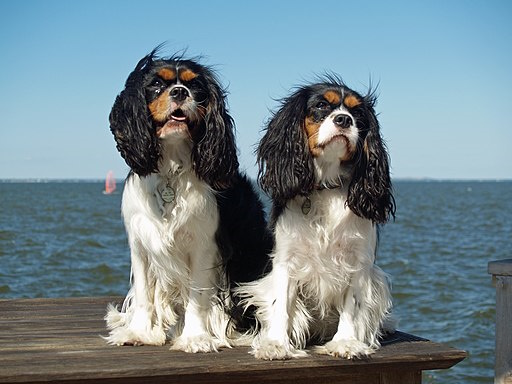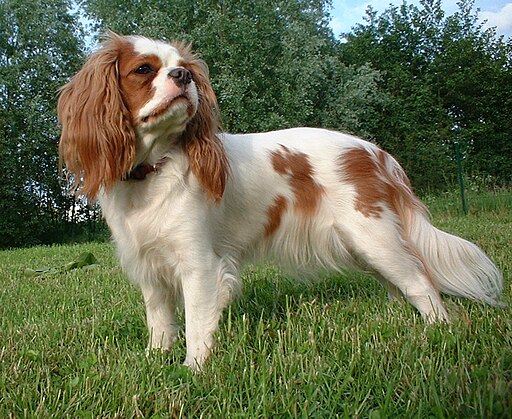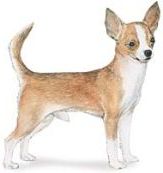Cavalier King Charles Spaniel
The Perfect Companion
The Cavalier King Charles Spaniel is graceful, affectionate, and endlessly charming — the epitome of a loving family pet. With his sweet demeanor and gentle nature, he’s often described as the perfect lap dog, and many agree that he is a wonderfully soothing companion.
While some may refer to this breed as the King Charles Cavalier Spaniel, the official name is actually Cavalier King Charles Spaniel, a nod to its royal heritage.
Whether you're unwinding after a long day or simply looking for a cuddly partner, the Cavalier’s calming energy is hard to resist. Many people find the breed to be a natural stress reliever, making them a perfect choice for those looking for emotional support in the form of a four-legged friend.
Though small in stature, don’t let their size fool you. Cavaliers are also fearless little dogs with a playful spirit. Their inherited sporting instincts may prompt them to chase after a passing squirrel or bird, so it’s best to keep them on a leash during outdoor adventures.
When it comes to training, Cavaliers are known for their eager-to-please attitude, making them highly trainable and well-behaved, especially when raised with patience and consistency. They thrive in environments where they’re treated with kindness and respect, and their friendly disposition extends to other pets and dogs as well.
History of the Cavalier King Charles Spaniel
The Cavalier King Charles Spaniel is a beloved breed with a rich history, deeply tied to European royalty. Known for its grace, elegance, and sweet temperament, the breed’s roots stretch back centuries, particularly with a strong connection to the royal courts of England. While you may encounter the name King Charles Cavalier Spaniel, the breed’s formal title is Cavalier King Charles Spaniel, named after King Charles II, who adored these dogs.
Royal Roots
The Cavalier’s story begins in 17th century England, where it was a favorite companion of King Charles II. These charming spaniels were often seen in portraits of the time, lounging on the laps of royalty. In fact, the breed's name honors the king who adored them.
The breed’s lineage traces back to early toy spaniels that were popular in China and Japan, eventually brought to Europe during the 16th and 17th centuries. These early spaniels were prized for their small size, beauty, and affectionate nature.
World War II and the Breed's Revival
World War II significantly disrupted the breeding of Cavaliers. Due to the war, there was a scarcity of suitable stud dogs, leading to a period of inbreeding that affected the breed’s development. After the war, efforts were made to restore the Cavalier to its former glory. This led to the breed looking somewhat different from its pre-war ancestors.
During the later 19th century, Queen Victoria became a fan of the breed and helped further solidify its place in royal circles. The Cavalier King Charles Spaniel we know today is a product of these breeding efforts, refined through the ages to maintain its beloved characteristics of loyalty, intelligence, and grace.
A Favorite of Celebrities
Not just a royal companion, the King Charles
Cavalier
Spaniel has charmed celebrities and public figures throughout history. Notably, Elizabeth Taylor and Diane Sawyer were among the many famous owners of this breed.
Appearance And Grooming
The Cavalier King Charles Spaniel is an elegant, small-to-medium-sized breed with a lovely, flowing coat and expressive, dark eyes.
Height: 12 to 13 inches
Weight: 12-18 pounds
Despite their small size, Cavaliers have a robust build that makes them surprisingly agile and able to keep up with active owners.
Coat and Colors
One of the Cavalier's most distinctive features is its silky,
flowing coat. They have a drop coat, which
means their fur falls naturally, giving them a graceful and royal
appearance.
The Cavalier comes in four color variations:
- Black and Tan
- Ruby
- Blenheim (Chestnut and White)
- Tricolor (Black, White, and Tan)
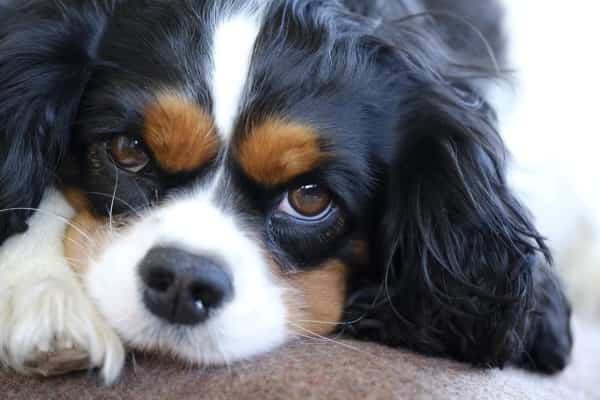 Bruno
BrunoGrooming
Brushing
- To maintain their gorgeous coat, it’s important to brush your Cavalier several times a week. Their long, silky fur can easily become tangled, so make sure to spend extra time on the areas behind the ears and around the chest.
Best Tools for Grooming
Investing in
high-quality brushes can make a significant difference in the
grooming process. Professional show dog handlers often use the
following:
- Pin brush: Great for detangling and smoothing out the coat.
- Boar brush: Helps with shine and distributing natural oils
- De-tangling Spray: Makes brushing more
comfortable for your dog and prevents mats.
While these tools may be higher in cost, the effort is worth it for your Cavalier’s comfort and appearance.
If you're not planning on entering your Cavalier in dog shows, you can opt for a shorter cut to reduce grooming time. Just be sure to consult a professional groomer who knows the breed’s specific needs.
Nail and Ear Care
- Nail Trimming: Trim your Cavalier’s nails at least once a month to prevent overgrowth.
- Ear Cleaning: Cavaliers are prone to ear infections because of their long, floppy ears. Inspect and clean them weekly, using an ear-safe cleaner recommended by your vet.
Teeth and Bathing
- Teeth Care: Brush your Cavalier’s teeth daily to avoid dental issues like tartar build-up. Dental problems can lead to more serious health issues, so this step is crucial.
- Bathing: Cavaliers are naturally clean dogs, so they don’t need frequent baths. Bathing once every 6-8 weeks should be sufficient unless your dog gets especially dirty. Overbathing can strip their coat of natural oils, which can cause dryness or irritation.
Show Dogs vs. Pet Grooming
- If your Cavalier is heading to the show ring, remember that show dogs should never have their coat trimmed, except for between the pads of their feet. However, if you have a pet Cavalier, feel free to keep their coat shorter to make grooming easier.
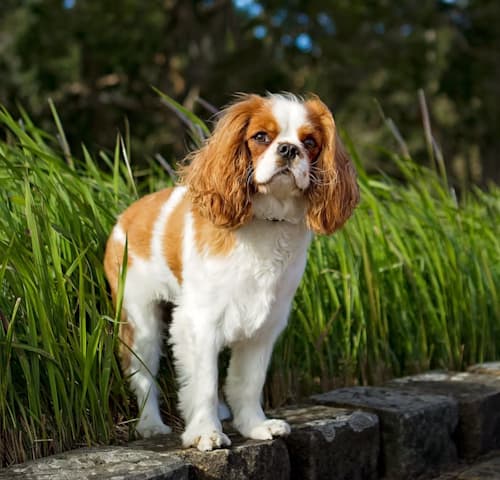
Cavalier King Charles Spaniel Health
The Cavalier King Charles Spaniel is a loving and devoted breed, but they are prone to certain inherited health conditions.
Among the health problems that may affect the Cavalier, the degenerative heart condition MVD Mitral Valve disease is the most frequently reported one.
Other health issues to be aware of include:
- Syringomyelia: A serious neurological condition where fluid-filled cavities form within the spinal cord. It’s caused by a malformation of the skull, leading to pressure on the brain and spine. It is characterized by persistent scratching in the neck area. The pain can be managed through various medications.
- Mitral Valve disease: A degenerative heart condition in which the mitral valve malfunctions, allowing blood to leak backward into the heart. It typically presents as a heart murmur and can lead to heart failure over time.
- Hip dysplasia: A genetic joint disease that results from the malformation of the hips and is characterized by joint weakness, stiffness, and pain caused. Depending on the severity of the condition, a veterinarian may advise pain medication or surgery.
- Patella luxation aka slipping kneecap: As the name implies, this involves a dislocation of the kneecap to varying degrees and is usually an inherited defect and more common in toy or smaller breeds. Responsible breeders will screen more than one generation of parents for this condition, before breeding, as well as the resulting puppies, before they are offered for purchase. An early sign of Patella Luxation is limping.
- Middle Ear disorders: Due to their long ears, Cavaliers are susceptible to ear infections and other ear-related issues.
- Eye conditions: These may include juvenile cataracts, dry eye, and retinal problems.
The American Cavalier King Charles Spaniel Club recommends that breeders screen for the following conditions:
- Patella Evaluation
- Hip Evaluation
- Cardiac Exam (by a veterinary cardiologist)
- Ophthalmologist Evaluation
Responsible breeders will test both sire and dam and provide documentation. Always ask to see these results before purchasing a puppy.
With the benefit of good home care, a high quality diet, adequate exercise and regular check-ups with a veterinarian, pet parents can expect to enjoy their Cavalier for up to fifteen years.

Activity Level And Space Needs
One of the advantages of this breed is its adaptability. Cavaliers are comfortable living in small apartments, as long as they receive enough attention and have access to regular outdoor walks. That said, they do enjoy being outside, so having access to a small yard or garden for playtime is a bonus.
While they are happy to lounge inside with their family, they do appreciate playtime and the opportunity to explore, even if it’s just a quick potty break outside.
Although the Cavalier can be content with any level of exercise, it is recommended that at least one walk a day is given to maintain a healthy heart condition, as well as for the mental stimulus and fresh air that every dog needs.
Pet parents may also want to involve the Cavalier in agility in which the breed has done well.
Milder climates suit the breed best.
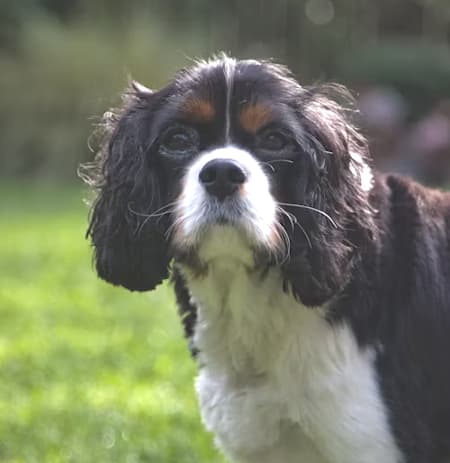
Living With Children?
The Cavalier King Charles Spaniel is a gentle dog and considered to be a good choice for families with children who have been taught how to interact and be considerate of pets.
However, because it is a delicate breed, it is not recommended for very young children who might accidentally hurt the dog.
As always, the caution remains that activities involving children of any age should always be monitored by an adult just to be on the safe side.
Living With Seniors?
Considering that exercise and grooming needs are not demanding, the Cavalier King Charles Spaniel is a good breed for the elderly or more sedentary family, with one condition.
The Cav loves companionship so someone should be home most of the time, or put another way, don't leave him alone too long!
Remember, small dogs can suffer from separation anxiety which often leads to undesirable behavior or depression.
Find A Cavalier to Buy Or Adopt
Once you've decided to welcome a Cavalier King Charles Spaniel into your home, the first step is to connect with a reputable breeder. The American Cavalier King Charles Spaniel Club is an excellent resource to help you find reliable breeders, and they can also assist in deciding whether you want a puppy, an adult dog, or even a rescue.
A dedicated breeder will generally be a member of this club and will adhere to its code of ethics. This ensures that they are committed to maintaining the breed’s health and well-being.
Avoid casual breeders, pet shops, or puppy mills, as they often prioritize profit over the health of the breed. These sources may not adhere to ethical breeding practices and often do not prioritize long-term health or genetic testing.
Other Helpful Resources:
- American Kennel Club (AKC) Marketplace: This is another trusted platform to find available puppies and reputable breeders.
- Dog Shows: Attend a dog show in your area to meet breeders, observe adult Cavalier Spaniels, and speak with their owners. It’s also a great opportunity to learn about the breed in person.
Important Considerations When Meeting a Breeder:
Before meeting with a breeder, it’s a good idea to have a list of questions prepared. A reliable breeder will be transparent about the health history of the puppy's parents and will encourage you to meet them.
An ethical breeder will also ask you questions to ensure their puppies are going to a suitable and loving home. They will want to know about your experience with dogs, particularly Cavaliers, and the environment you can provide.
Cavalier King Charles Spaniel Puppy Prices:
The cost of purchasing a Cavalier King Charles Spaniel puppy generally ranges from $1,000 to $2,500. Several factors can influence the price, including the breeder’s reputation, the puppy's lineage, coat color, and the results of health testing done on the puppy’s parents.
FAQ
What should I look for in a Cavalier King Charles Spaniel breeder?
What should I look for in a Cavalier King Charles Spaniel breeder?
Look for a breeder who is a member of the American Cavalier King Charles Spaniel Club and follows their code of ethics. A reputable breeder should be transparent about the health history of their dogs and encourage you to meet the puppy's parents. They should also ask you questions to ensure their puppies are going to a loving, knowledgeable home.
Is it a good idea to adopt an adult Cavalier King Charles Spaniel?
Is it a good idea to adopt an adult Cavalier King Charles Spaniel?
Yes! Adopting an adult dog can be a wonderful option if you prefer to avoid the challenges of raising a puppy. Many adult Cavaliers are in need of loving homes, and you can find adult dogs available for adoption through breed-specific rescues or by attending local dog shows.
What is the difference between a puppy, adult, or rescue Cavalier King Charles Spaniel?
What is the difference between a puppy, adult, or rescue Cavalier King Charles Spaniel?
What questions should I ask a Cavalier King Charles Spaniel breeder?
What questions should I ask a Cavalier King Charles Spaniel breeder?
Before You Go...
If you like the content of this page, as well as others on my site, please give it some love by clicking on the heart in the lower right hand corner. This helps me keep providing enjoyable and useful content.
Thank you.
More Small Dog Breeds
- Home ›
- Miniature Breeds ›
- Cavalier Spaniel

